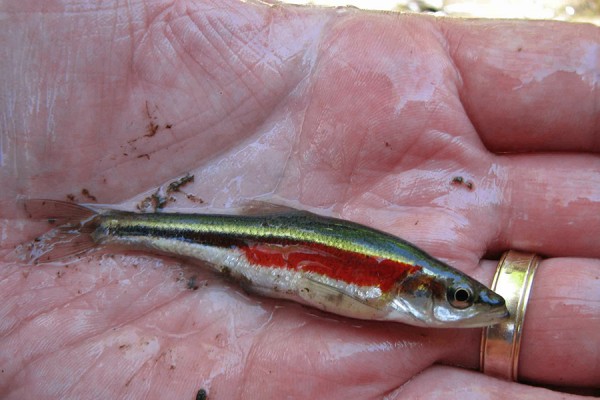 The redside dace turns bright red during its spawning season.
The redside dace turns bright red during its spawning season.
A UWindsor researcher studying how to bring a small but significant fish back from the brink of extinction is receiving some additional support from the federal government.
Trevor Pitcher, director of UWindsor’s Freshwater Restoration Ecology Centre on the Detroit River in LaSalle, has received a $50,000 grant from the Department of Fisheries and Oceans’ Canada Nature Fund for Aquatic Species at Risk for his work with the redside dace.
The minnow — remarkable for its ability to jump half a metre out of the water to pluck insects out of the air and for the bright red colour it turns during spawning season — is poised to become the model for how to reintroduce endangered freshwater species to the wild, Dr. Pitcher said.
The grant is one of six projects being funded in the first year of a five-year initiative. Jonathan Wilkinson, Minister of Fisheries, Oceans and the Canadian Coast Guard, announced the funding of six projects totalling more than $790,000 as part of a five-year, $55 million strategy.
“DFO recognizes the importance of taking prompt action in helping these aquatic species at risk recover,” the federal government announced. “These initial one-year projects will help address immediate needs and threats in areas across the country and provide a real benefit to species at risk.”
Pitcher said his research promotes the recovery of a species that could otherwise become extinct within a decade.
“It’s important for understanding what habitats to protect in the context of turbidity and thermal stressors,” Pitcher said of the research.
The redside dace is a piscine version of a canary in a coal mine, a bioindicator of an ecosystem’s health. Only a few small populations remain in Canada.
Pitcher’s research on the redside dace began last year and includes guidelines and protocols for creating a captive breeding population to one day perform reintroductions into streams in and around the Greater Toronto Area. The species is disappearing from its natural habitat, in part, because of rising water temperatures attributed to urbanization.
The $50,000 grant will allow Pitcher to study the genetic mechanisms of thermal tolerance of the redside dace to provide conservation managers better information about thresholds related to habitat quality. He will bring more students on board in his lab to work with the cutting-edge genomics equipment at UWindsor’s Great Lakes Institute for Environmental Research.
Pitcher said the funding will allow his team of researchers to provide managers critically needed thermal thresholds and their related genetic mechanisms for species at risk.
“We are going to be able to tell them exactly what this species can tolerate in the context of thermal stress.”
Pitcher said the redside dace populations are suffering in the short term from sudden fluctuations in water temperature due to storm water and other effects of urbanization, and in the long term because of climate change.
“This funding is important,” Pitcher said. “Without this funding, we wouldn’t understand thermal tolerance and the mechanisms for habitat protection for this very important endangered species.”
K.W. Michael Siu, UWindsor’s vice-president, research and innovation, said the grant is important to the university.
“It’s a fantastic opportunity and I am delighted the DFO is supporting University of Windsor research,” Dr. Siu said. “This is important research that will preserve a species in the natural environment.”
—Sarah Sacheli
